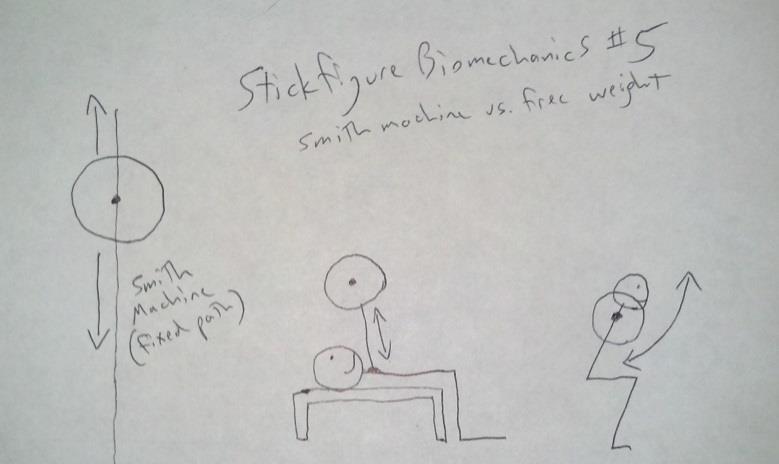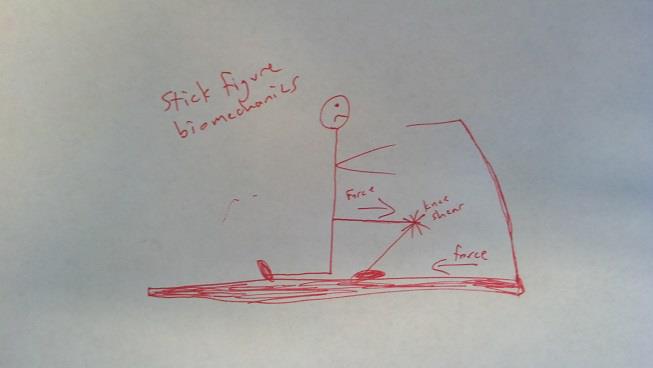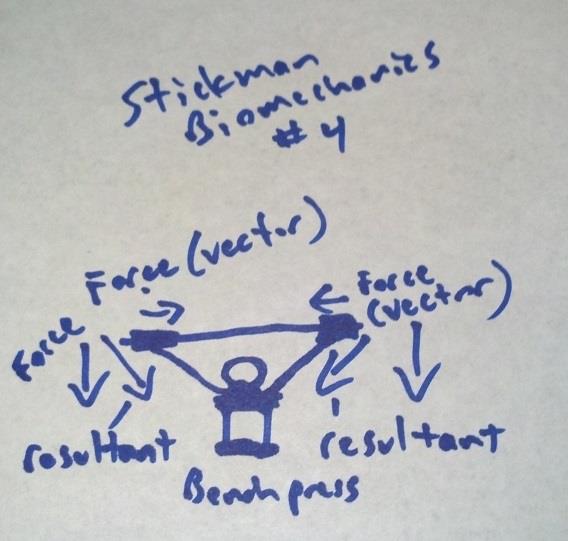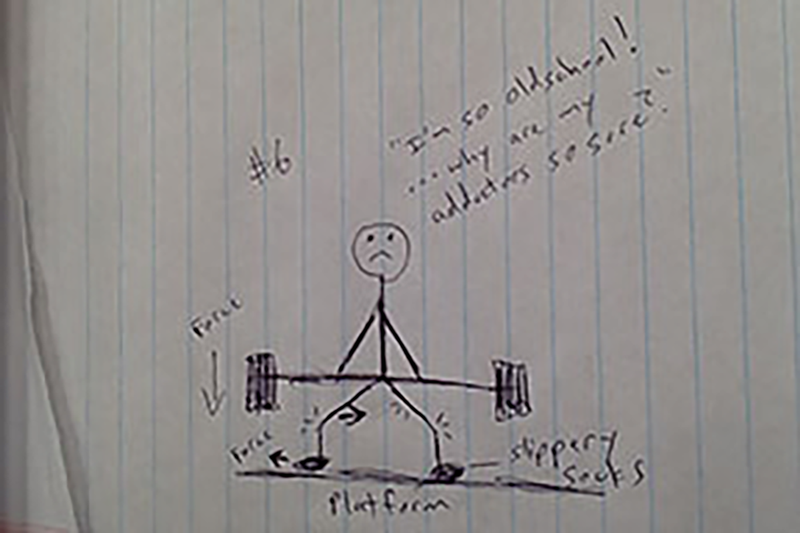Even seemingly rational and educated people seem to throw common sense out the window when they step into the weight room. So, I started a fun little series of crappy drawings called “Stickman Biomechanics” on Facebook explaining basic biomechanics and to give people some pause before they “just do it, Brah.”
Today I bring you 2 super common exercises that I see in most gyms on a regular basis. Both of these are perfect examples of mimicking motion without regard to what is actually happening.
Some basics of resistance training that need to be understood:
OK. Now look at an anatomy chart and notice which muscles are responsible for moving the “lever” at each “fulcrum”.
Please, baby Jesus, tell me this makes sense.
OK. Now, you should also notice that each “fulcrum” or joint has a preferred motion. For example: your elbow likes to flex and extend your arm. It does not like to move perpendicular to that movement. That’s called a lateral condyle fracture, and that will ruin your day. So, it goes without saying, that you should not load a joint in a way that forces it outside of its range of motion.
OK, now for the muscle stuff. In order to work a particular muscle, you need to apply force in such a way that the muscle MUST respond to control the joint you are applying force to. Look at the pectorals. You do a dumbbell chest press on your back because this allows the force to be applied to the joint in such a way that the pectorals (ignoring secondary muscles) is responsible for controlling that movement (because gravity wants to bring the weight to the floor). You can mimic the same motion standing, but the force is now applied primarily to the deltoids, rather than the pecs (once again…gravity).
The cool thing about gravity is that it is always applying force downward.
The cool thing about free cables is that they are always applying force in the direction of the cable.
This means that it is crucial that you adjust the cable to correspond with how you want to apply force to the joint (and surrounding muscle). A lot of people ignore the force and just make the movement.
Note the examples below.
In a cable fly, if you have the cable adjusted at an upward angle, but you are moving your arms parallel to the floor with the intent of working your pecs, you are applying force at the wrong angle (this is why you see people leaning forward in a fly to change the angle of the joint in correspondence with the force-although most people don’t realize why they are doing it).
In a cable shoulder press, the same rules apply. Pay attention to the force angle and what muscles are actually being used to control that force. To do this correctly (assuming you want to work the deltoids), the line of force would need to be almost directly straight down.
Stickman is sad because:
a) the force is creating torque in an unnatural way against the joint and that shit hurts
b) stickman can’t feel the muscle working the way he would like
c) he will never get jacked and swolt
BONUS: Cable flyes can be AWESOME for pec development if used correctly. It’s super easy to change the direction of force by just stepping forward or backing up more. Remember, the cable is the direction of force, so it makes it easy to see.
Remember, friends, your body is a machine and physics applies to its movement just like any other machine.
Even seemingly rational and educated people seem to throw common sense out the window when they step into the weight room. So, I started a fun little series of crappy drawings called “Stickman Biomechanics” on Facebook explaining basic biomechanics and to give people some pause before they “just do it, Brah”.
Below are 2 that people really seemed to enjoy, 1 that really pissed people off, and 1 bonus new one.
ENTER STICKMAN.

The thought is that the smith machine is “safer”. The problem is that the fixed path (whether linear or angled) causes stress on shoulders, elbows, spine, hips, and knees because you are forcing an unnatural angle onto these joints.
I see a lot of injuries from peeps loading up the smith machine to “safely max out” on bench, deadlifts, and shoulder presses. The thought is that the smith machine is “safer”. The problem is that the fixed path (whether linear or angled) causes stress on shoulders, elbows, spine, hips, and knees because you are forcing an unnatural angle onto these joints. Adding to possible damage from the unnatural path of motion on the joint, lifters will load a crap-ton of weight because a smith machine is “safer”.
Better choice? Use a squat cage with self spotters or use a (competent) human spotter. I’m not saying the smith is useless, I’m just saying don’t trick yourself into thinking it’s safe. BTW, the smith is a terrible way to “get used to squatting”. The mechanics and inherent stabilization does not teach proper squat movement.

I think the drawing is self-explanatory, but if you have 2 oposing forces that are focused on the knee, you will get shear in that joint. Now do this for 30-45 minutes and you are just destroying cartilage.
Man, I caught bunch of shit for this one from physique prep coaches. So many people have been told to do these by their trainer (or by a magazine) that they have just become part of the process. Ignorant prep coaches still prescribe this to “really lean out the hamstrings and glutes.” Phshhh…that’s dumb. ANY exercise you do while prepping will bring out the hams and glutes. Why? BECAUSE YOU ARE IN A CALORIE DEFICIT! I could prescribe hand-jive and you would lean out your hamstrings if you are on a prep diet.
FYI…lunges are a crappy hamsting/glute exercise anyways. You would be much better off doing deadlift variations and hip thrusts.

Definition: resultant n (Physics / General Physics) a single vector that is the vector sum of two or more other vectors
The answer is a basic physics. Friction created by your hands on a fixed bar as you lift creates a secondary force. This secondary force, coupled with the force of gravity, creates a resultant which changes the angle of resistance. The resultant is especially prevalent if you take a wide grip.
NOTE: the more you push your hands out or in on the press changes the angle of resistance even more. This is also why pushups feel so different. The resultant is created by the force of gravity and the friction of your hands on the floor (do pushups on a slippery floor and “feel the burn”).

Those slippery socks are creating a force which must be counteracted by your adductors to keep you from doing the splits with 405 on your ball sack (or female equivalent)
I get it…you want to lift “old school”, but you have dirty feet or toe fungus. Thanks for leaving your socks on, Bilbo. However, there is a problem with this that may be affecting your lift: those slippery socks are creating a force which must be counteracted by your adductors to keep you from doing the splits with 405 on your ball sack (or female equivalent). You may not even notice it…but your muscles and nervous system do.
The secondary issue is that those two opposing forces can wreak havoc on your knee joint. Maybe not immediately, but over time. And guess what causes most catastrophic knee injuries? Prolonged and repetitive crappy movement patterns. No one actually blows their ACL stepping off a curb. Their ACL blows when they step off a curb because their ACL is weak from 10 years moving like a dumb-ass.
The same force happens if you squat in socks also, especially on a platform. In fact, this may create even greater stress on the knee due to the greater knee flexion inherent in a squat.
So, maybe you go get a good pair of shoes. Those can be “old school” too.
If you read this all the way to the end, I really appreciate it. If you have some positive input for me, let me know.
Recent Comments